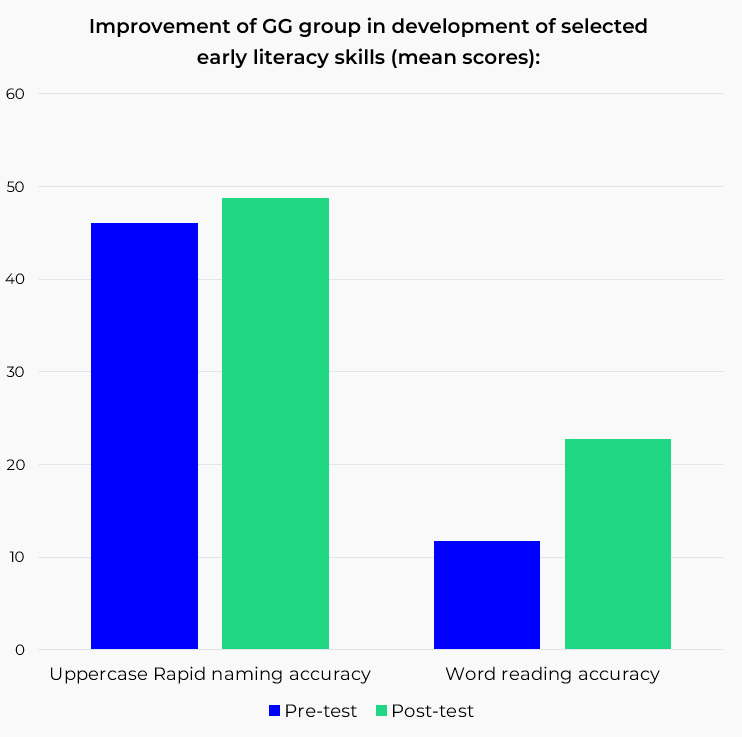Evidence
GraphoGame is a result of university-led research since the early 2000s. The research has been facilitated by the GraphoLearn Research team led by Professor Ulla Richardson based in the Centre for Applied Language Studies at the University of Jyväskylä in Finland.
GraphoGame has been adapted and researched to 17 languages and dialects in collaboration with multiple universities (see table).
The research project has sought to develop broad research across an unprecedented amount of languages while also strengthening evidence in several key language versions.
Many language versions have multiple studies and publications that have contributed to the growth and development of the app and its evidence-base
- University of Cambridge Neuroscience in Education
- Aix-Marseille University
- University of Groningen
- Politecnico do Porto
- Pontifical Catholic University of Rio Grande do Sul
- Pontifical Catholic University of Chile
- University of Zürich
- Beijing Normal University
- Academia Sinica
- University of Stavanger
- Lund University
- University of Jyväskylä
- University of Zambia
Foundational English literacy development in India: a randomised-control trial using phonics instruction and GraphoLearn
Article type
Report from Randomized Controlled Trial
Region
Republic of India
Version of GraphoGame
English GraphoLearn Rime
Participants
54
Grade
Grade 2
Subject
Effectiveness of combined reading interventions in English-medium schools in India
Citations
0
In this study, researchers explored whether combining classroom phonics lessons with GraphoLearn, a computer-based reading tool, could boost English phonological awareness and reading skills more effectively than phonics instruction alone. The participants were 54 students, aged 6 to 7, in Grade 2 at a public school in India, where English is taught as a second language. These students all received 35 minutes of phonics instruction three times a week in their classroom. On top of that, they were randomly assigned to either play a GraphoLearn-Rime game (28 students) or a math game (26 students) for 15–20 minutes daily. The goal was to see if the added digital tool could give these young learners an extra advantage in mastering the sounds of English and improving their reading skills.
Key findings
- GL group showed better results than the control group in in-game measures (letter-sound knowledge, rime-unit recognition, and word recognition) with large effect sizes.
- In the oral-and paper-based measures, both groups showed skill development, but the groups were not significantly different in the gains.
- Classroom phonics lessons can help students in India who struggle with reading by improving their ability to recognize sounds in words and develop early reading skills.
Bora, D., Patel, P., Psyridou, M., & others. (2024). Foundational English literacy development in India: A randomized-control trial using phonics instruction and GraphoLearn. Reading and Writing.
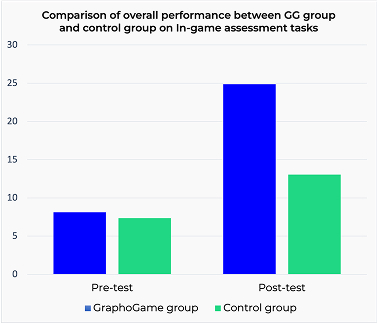
Assessing the Effectiveness of Two Theoretically Motivated Computer Assisted Reading Interventions in the United Kingdom: GG Rime and GG Phoneme
Article type
Empirical comparison study
Region
United Kingdom
Version of GraphoGame
English GraphoLearn Rime
Participants
31
Grade
Grade 2
Subject
Comparing 2 versions of a computer-assisted reading interventions: GG Phoneme and GG Rime
Citations
121
This study compared the effectiveness of two computer-based reading interventions for struggling 6–7-year-old readers: GraphoGame Rime and GraphoGame Phoneme. Over 12 weeks, students played one of the games during literacy lessons, while a control group received no intervention.
Key findings
- The study found that 11 hours of exposure to GG Rime over a 12-week period resulted in substantial gains in literacy skills. Specifically, medium to large improvements were observed in reading (34–38%) and spelling (40–45%), while phonological awareness and nonword reading showed even greater gains (50–60%).
- In comparison, GG Phoneme showed smaller gains in reading (10–15%) and spelling (20–25%), but phonological awareness improved significantly (50–65%), alongside moderate progress in nonword reading (30–35%).
- GG Rime had a higher rate of improvement per hour of use compared to GG Phoneme, meaning it was more effective in improving scores over the same amount of time (graph).
Kyle, F., Kujala, J., Richardson, U., Lyytinen, H., & Goswami, U. (2013). Assessing the effectiveness of two theoretically motivated computer-assisted reading interventions in the United Kingdom: GG Rime and GG Phoneme. Reading Research Quarterly, 48(1)
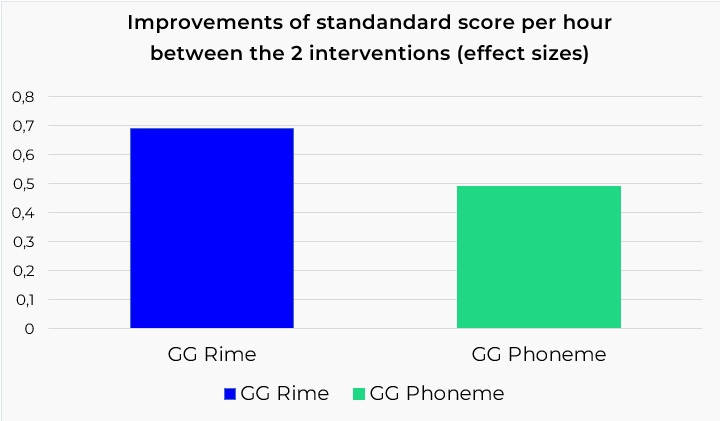
GraphoGame Rime Evaluation report- Randomized controlled trial
Article type
Randomized Controlled Trial
Region
United Kingdom
Version of GraphoGame
English GraphoGame Rime
Participants
398
Grade
Grade 2
Subject
Reading interventions on English reading skills for children in United Kingdom
Citations
4
Researchers conducted a randomized controlled trial (RCT) with 398 Year 2 students (ages 6–7) across 15 UK primary schools who hadn’t passed the Year 1 Phonics Check. Students were split into two groups: one used GraphoGame Rime (GG Rime) during Literacy Hour, while the other followed the standard phonics curriculum taught by teachers. Outcomes were measured using the New Group Reading Test (NGRT) and Single Word Spelling Test (SWST), administered by independent evaluators to ensure unbiased results shortly after the intervention.
Key findings
- GG Rime matched traditional classroom phonics in improving literacy skills, offering a cost-effective alternative.
- Teachers found the program easy to implement and felt well-trained.
- GraphoGame Rime was engaging and enjoyable for teachers, students, and school leaders, with strong implementation fidelity.
Worth, J., Nelson, J., Harland, J., Bernardinelli, D., and Styles, B. (2018). GraphoGame Rime: Evaluation Report and Executive Summary. London: Wellcome Trust.
https://www.nfer.ac.uk/media/idlhbicn/graphogame_rime_evaluation_report_and_executive_summary.pdf
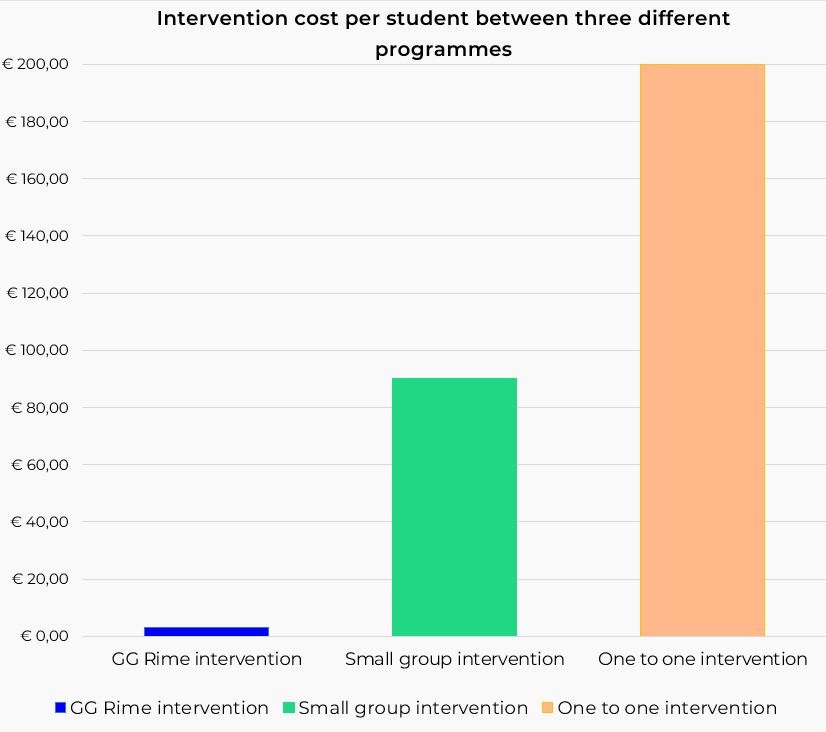
An Evaluation of the Efficacy of GraphoGame Rime for Promoting English Phonics Knowledge in Poor Readers
Article type
Follow-up analysis from RCT by Worth et al. (2018)
Region
United Kingdom
Version of GraphoGame
English GraphoLearn Rime
Participants
291
Grade
Grade 2
Subject
Further analysis of reading interventions on English reading skills for children in United Kingdom
Citations
13
Ahmed et al. (2020) have performed a follow-up analysis focused on the “top half” of GG Rime players from the original RCT—95 students who advanced beyond the mean play progress point. These students, averaging 8.5 hours of gameplay, were compared to the full control group (196 students). The study also examined three subgroups within the GG Rime group: students with Individual Education Plans (IEPs) – (N=15), younger students born in spring and summer (N=51), and students from schools rated as “requiring improvement” (N=27). The analysis aimed to identify which contexts and student groups benefited most from GG Rime, considering its cost-effectiveness and ease of implementation.
Key findings
- Both groups performed similarly on the main tests, but the GG Rime group scored slightly higher, especially in spelling and phonics decoding (nonword reading).
- The GG Rime group improved by an average of 5.4% across all tasks compared to the control group.
- Children with Individual Education Plans (IEPs) who played GG Rime showed a 25% greater improvement in spelling than those receiving “business-as-usual” instruction.
- GG Rime also delivered notable benefits in underperforming schools, highlighting its potential as a cost-effective tool for early literacy support.
Ahmed, H., Wilson, A., Mead, N., Noble, H., Richardson, U., Wolpert, M. A., & Goswami, U. (2020). An evaluation of the efficacy of GraphoGame Rime for promoting English phonics knowledge in poor readers. Frontiers in Education, 5, Article 132.
https://www.frontiersin.org/journals/education/articles/10.3389/feduc.2020.00132/full
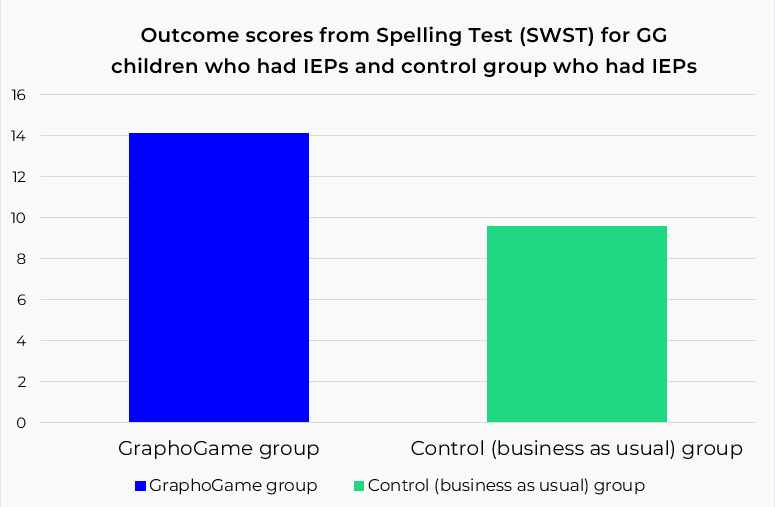
The effectiveness of a computer-assisted reading intervention in supporting struggling readers of English
Article type
Report from Randomized Controlled Trial
Region
Republic of India
Version of GraphoGame
English GraphoLearn Rime
Participants
30
Grade
Grade 3
Subject
Reading interventions on English reading skills for children in India
Citations
24
In this study it was tested whether GraphoLearn, a computer-based reading tool, could help struggling young readers in India improve their English skills. The study involved 30 third-graders, aged seven, from an English-medium public school in Ahmedabad, none of whom spoke English as their first language. Over eight weeks, one group used GraphoLearn, while the other played a math game as a control activity, for 20–30 minutes daily.
Key findings
- Children who played GraphoLearn for a limited amount of time (∼7.5 hours) have showed massive improvement in letter-sound knowledge, a critical skill for early reading development.
- There has been moderate improvement in word recognition and rime unit tasks but due to smaller sample size it is difficult to obtain significant results.
- GraphoLearn demonstrated an efficient intervention to improve essential reading skills, particularly in letter-sound knowledge, laying a strong foundation for struggling readers to build upon.
- Its impact, especially in non-native English learners, highlights its value as a tool for addressing literacy challenges in diverse educational contexts.
Patel, P., Torppa, M., Aro, M., Richardson, U., & Lyytinen, H. (2018). GraphoLearn India: The effectiveness of a computer-assisted reading intervention in supporting struggling readers of English. Frontiers in Psychology, 9, 1045.
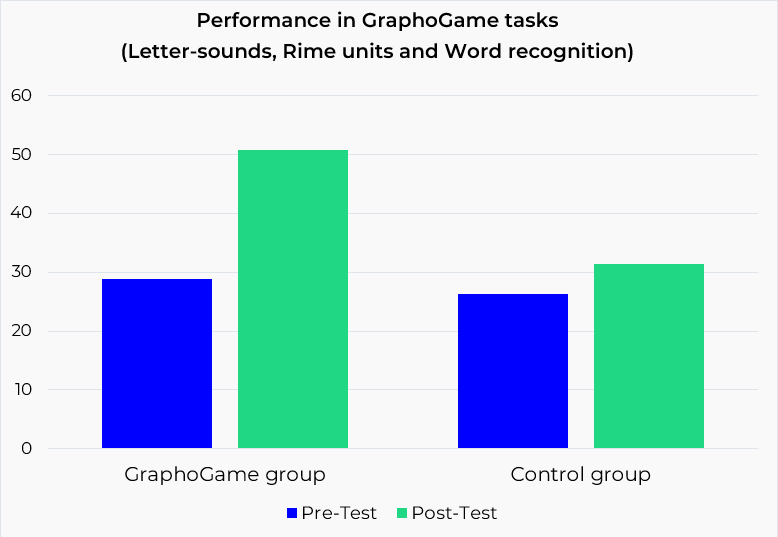
Assessing the effectiveness of a game-based phonics intervention for first and second grade English language learners in India: A randomized controlled trial
Article type
Report from Randomized Controlled Trial
Region
Republic of India
Version of GraphoGame
English GraphoLearn Rime
Participants
54
Grade
Grade 2
Subject
Effectiveness of combined reading interventions in English-medium schools in India
Citations
142
The randomized controlled trial (RCT) included 136 Grade 1 and 2 students, averaging 6.2 years old, from a Delhi public school where English was the primary language and Hindi was secondary. Using a matched-pairs design, students were assigned to two groups: 69 played GL English Rime, a literacy game, while 67 played Math Kids, a Hindi math game aligned with the curriculum. Both groups participated in supervised 20-minute smartphone sessions, five days a week, for five weeks. Pre- and post-intervention assessments included both game-based and traditional oral and paper-based tasks.
Key findings
- Children who played GL English Rime significantly outperformed those in the control group on game-based measures of English reading skills.
- On average, a participant in the GL group outperforms the control group by approximately 94% across the three tasks.
- There were no significant differences between the GL and control groups in oral and paper-based reading and spelling tasks, indicating that the skills learned in the game did not transfer to real-world literacy contexts.
- Children with higher pre-literacy skills showed better performance results and overall more improvement.
Patel, P., Torppa, M., Aro, M., Richardson, U., & Lyytinen, H. (2022). Assessing the effectiveness of a game‐based phonics intervention for first and second grade English language learners in India : A randomized controlled trial. Journal of Computer Assisted Learning, 38(1), 76-89.
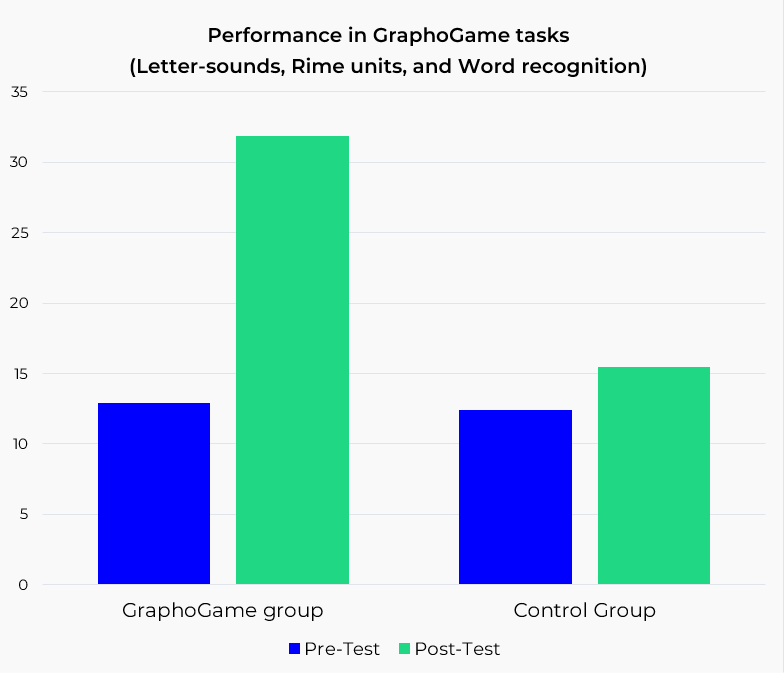
GraphoGame: a digital tool for children with difficulties in learning-to-read
Article type
Report from Randomized Controlled Trial
Region
France
Version of GraphoGame
French GraphoGame
Participants
69
Grade
Grade 1, Grade 2
Subject
Effectiveness of a computer-assisted reading intervention on poor readers in France
Citations
10
This study has explored the effectiveness of a French version of GraphoGame, a smartphone and tablet game designed to help children at risk for dyslexia. The game has been adapted to the French language’s unique features, focusing on the connections between sounds, letters, and word recognition. In a randomized controlled trial (RCT) with 1st and 2nd grade students, those who used GraphoGame showed more improvement in reading familiar words compared to kids who received traditional non-computerized support or math training on a computer.
Key findings
- GG showed a significant improvement in reading speed and accuracy of familiar words for children in 1st grade after just 5 weeks of training (2 hours 50 minutes), compared to a traditional classroom training.
- GG training led to a significant increase in reading speed of 2nd grade students.
- GG likely aids in reading aloud familiar words, but might have a stronger impact on silent reading tasks or spelling-based assessments.
- 1st grade children with lower initial reading levels benefited more from GG, suggesting the tool is particularly effective for children with reading difficulties.
- In the 2nd grade, children who showed better response to GG had a higher vocabulary level, indicating that vocabulary might be a predicting factor in improving reading skills through GG.
Ruiz, J.-P., Lassault, J., Sprenger-Charolles, L., Richardson, U.A, Lyytinen, H. & Ziegler, J.C. (2017). GraphoGame : un outil numérique pour enfants en difficultés d’apprentissage de la lecture. A.N.A.E., 148, 333-343.
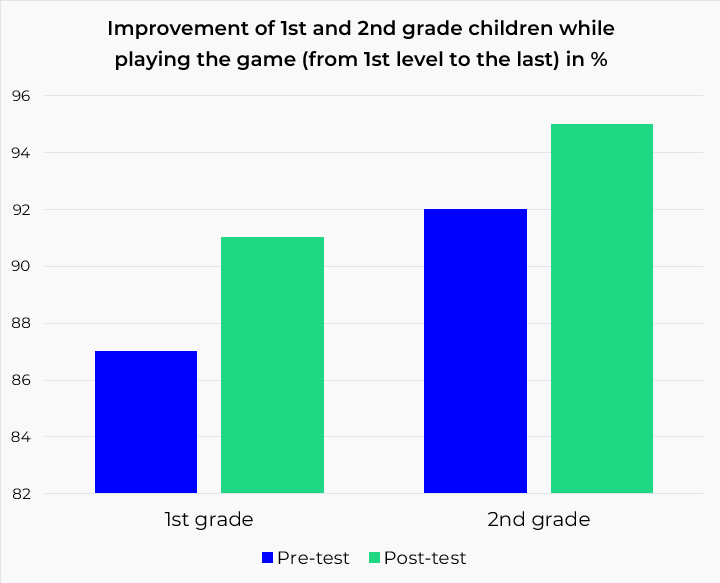
Testing the Effects of GraphoGame Against a Computer-Assisted Math Intervention in Primary School
Article type
Report from Longitudinal quasi-experimental study
Region
France
Version of GraphoGame
French GraphoGame
Participants
921
Grade
Grade1, Grade 2
Subject
Effectiveness of a computer-assisted reading intervention on socioeconomically disadvantaged children in France
Citations
8
This study assessed the effectiveness of a French version of GraphoGame (GG), a reading intervention, compared to Fiete Math (FM), a math intervention, in 921 first-grade students from socioeconomically disadvantaged neighborhoods in Marseille, France. Over two cohorts, students used GG or FM for four months, four times per week for 30 minutes per session. The French GG was tailored to the first-grade curriculum, progressively teaching grapheme-phoneme correspondences (GPCs) in frequent and consistent contexts.
Key findings
- GraphoGame significantly improved phoneme awareness and word recognition, especially for children struggling with early literacy.
- The game moderately enhanced word reading fluency, helping students read more accurately and slightly faster, even though fluency wasn’t directly trained.
- Minimal effects on pseudoword reading fluency were seen, mostly benefiting children with stronger initial skills, as the game focused on real-word recognition.
- GraphoGame is more efficient at helping kids recognize and understand written words (orthographic skills) than improving how quickly they can read them.
Lassault, J., Sprenger-Charolles, L., Albrand, J.-P., Alavoine, E., Richardson, U., Lyytinen, H., & Ziegler, J. C. (2022). Testing the effects of GraphoGame against a computer-assisted math intervention in primary school. Scientific Studies of Reading.
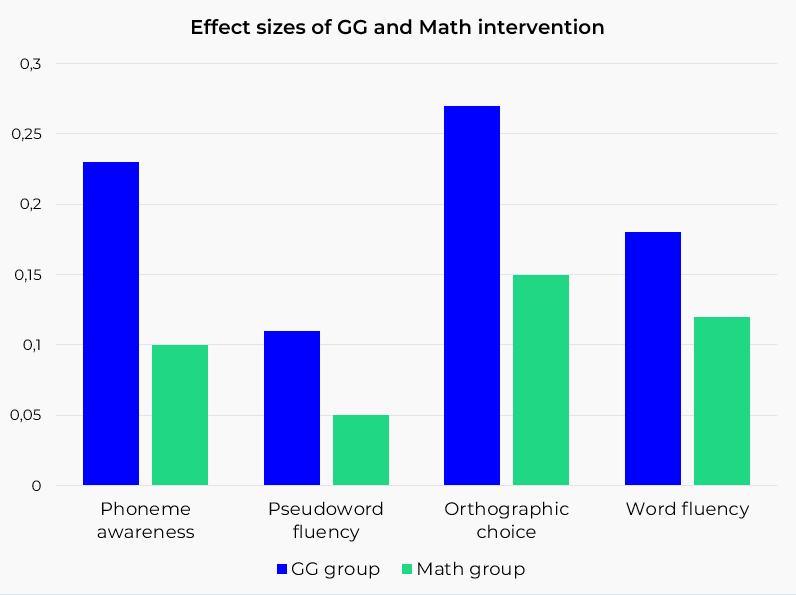
Testing the Effects of GraphoGame Against a Computer-Assisted Math Intervention in Primary School
Article type
Report from machine-learning based, longitudinal educational study
Region
Norway
Version of GraphoGame
Norwegian GraphoGame
Participants
1,562
Grade
Grade1
Subject
Implementing machine learning analysis of GG gameplay for predicting future reading skills of 1st graders in Norway
Citations
0
This study introduces a machine learning approach using data from GraphoGame, a literacy app designed to support early reading skills. The final data sample was comprised of 1,562 Norwegian first graders who played the app for 10 minutes daily over five weeks.
The process data collected during gameplay was combined with end-of-year national screening test results to train predictive models, offering a more reliable method for early identification of reading difficulties.The main goal in the present study was to evaluate the potential of machine learning analyses of gameplay features in predicting whether a student will be classified as a weak reader at the end of first grade.
Key findings
- Machine learning models (bagfda & boostglm) improved detection, identifying 72–80% of at-risk students.
- Higher sensitivity led to more false positives, but detecting more at-risk students (as opposed to not detecting at-risk students) is preferable for early intervention.
- Gameplay data from just five weeks proved effective for predicting early reading difficulties, supporting machine learning as a valuable screening tool.
Foldnes, N., Uppstad, P. H., Grønneberg, S., & Thomson, J. M. (2024). School entry detection of struggling readers using gameplay data and machine learning. Frontiers in Education, 9, Article 1487694.
https://www.frontiersin.org/journals/education/articles/10.3389/feduc.2024.1487694/full
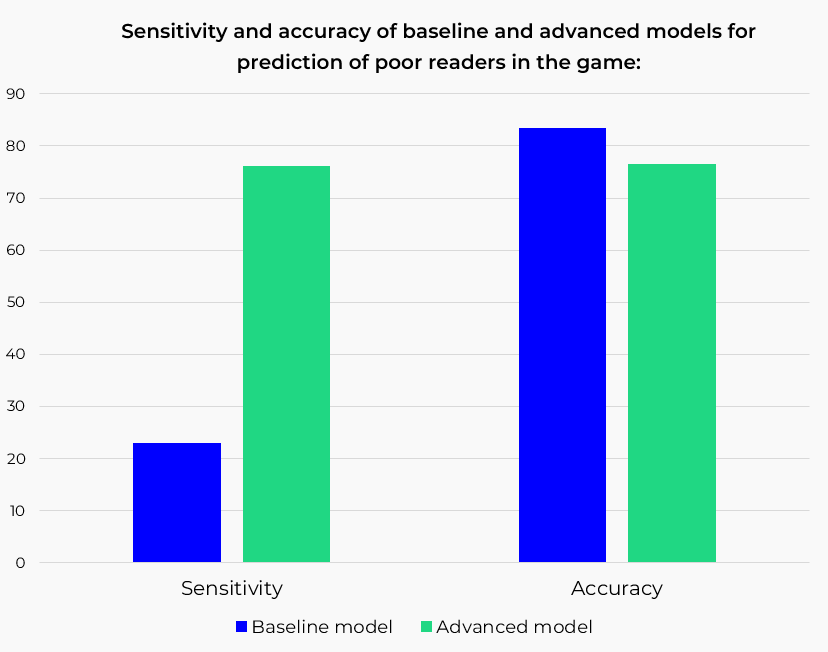
Effectiveness of an early reading intervention in a semi-transparent orthography: A group randomised controlled trial
Article type
Report from group RCT
Region
Norway
Version of GraphoGame
Norwegian GraphoGame
Participants
744
Grade
Grade1, Grade 2, Grade 3
Subject
Effectiveness of 2 different computer-assisted reading intervention on early reading skills in Norway
Citations
34
This study reports on the effectiveness of an early reading intervention designed for Norwegian students, based on current research on early reading acquisition. Thirteen schools were randomly assigned to one of two intervention programs or a control group. First graders (744 total) were screened, and 140 at-risk students received extra teacher-led instruction combined with a computer-based learning tool. The key difference between the two interventions was whether the computer program adapted to each child’s progress.
Key findings
- Both intervention programs—fixed and adaptive—significantly improved reading and spelling skills compared to the control group.
- Intensive early reading support can be highly effective for first graders learning in semi-transparent orthographies like Norwegian.
- The reading skills gained through the program remained strong even two years after the intervention, demonstrating lasting impact.
Solheim, O. J., Frijters, J. C., Lundetræ, K., & Uppstad, P. H. (2018). Effectiveness of an early reading intervention in a semi-transparent orthography: A group randomised controlled trial. Learning and Instruction, 58, 65-79.
https://www.sciencedirect.com/science/article/pii/S0959475217304565
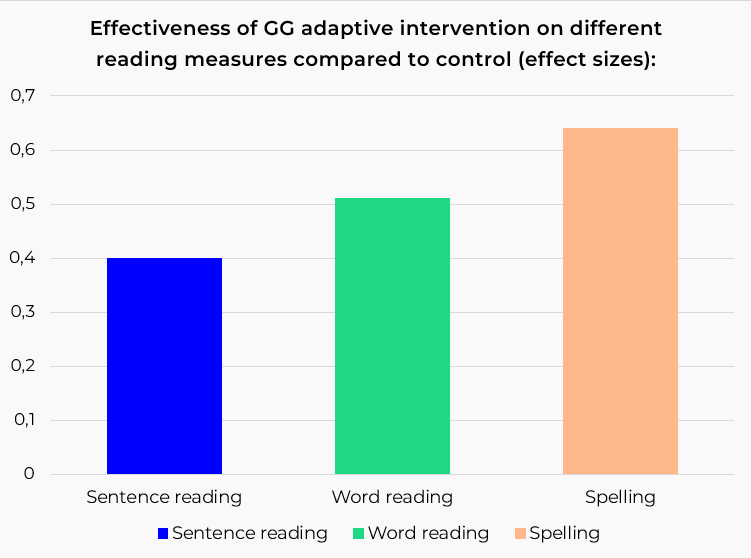
Impact of a computer-based intervention in Chilean children at risk of manifesting reading difficulties
Article type
Report from an Experimental study
Region
Chile
Version of GraphoGame
Spanish GraphoGame
Participants
87
Grade
Grade1
Subject
Impact of GG on literacy learning for Spanish speakers from both high- and low- SES backgrounds
Citations
20
The study investigated the impact of a GraphoGame on first-grade children at risk of reading difficulties, focusing on children from both low and high socioeconomic status (SES) backgrounds. A total of 87 students, identified as being at risk based on their knowledge of letter names and sounds, participated in the study. They were divided into control and experimental groups, with the experimental group receiving a 30-minute daily session of the GraphoGame software for three months.
Key findings
- Students from high-SES backgrounds who were playing GG have showcased a better performance in Rapid automized naming (RAN).
- Low-SES participants showed notable gains in letter sound recognition, which is crucial for phonological awareness and early reading development, but these gains did not extend to lexical skills like word reading.
- Overall, GraphoGame has proven to proven to be an important aspect of developing sublexical skills that are needed to overcome reading difficulties in both low and high- SES groups.
Rosas, R., Escobar, J.-P., Ramírez, M.-P., Meneses, A., & Guajardo, A. (2017). Impact of a computer-based intervention in Chilean children at risk of manifesting reading difficulties / Impacto de una intervención basada en ordenador en niños chilenos con riesgo de manifestar dificultades lectoras. Infancia y Aprendizaje, 40(1), 158–188.
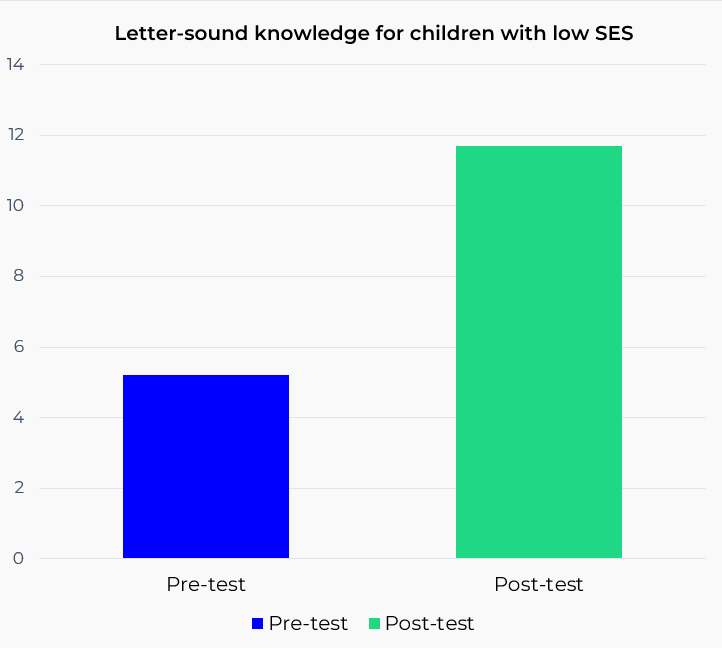
Graphogame intervention as a tool for early diagnosis of reading difficulties in Spanish-speaking children with developmental language disorder
Article type
Report from an Experimental study
Region
Chile
Version of GraphoGame
Spanish GraphoGame
Participants
59
Grade
Kindergarten, Grade1
Subject
Impact of GG on improving reading skills in Chilean Spanish-speaking children with DLD.
Citations
1
This study evaluates the effectiveness of GraphoGame (GG) in improving reading-related skills in kindergarten and first-grade Chilean Spanish-speaking children, particularly those with developmental language disorder (DLD). The second goal of the study is to investigate GG’s potential as a diagnostic instrument in the early identification of children at risk of developing serious reading difficulties.A total of 59 children (16 typically developing and 43 with DLD) participated in a six-week intervention, during which their performance in letter recognition, phonological awareness, and pseudoword recognition was assessed before and after using GG.
Key findings
- GG intervention has a positive effect on the reading-related skills of students learning to read in Chilean Spanish.
- GG may be used to support the reading acquisition, adding to the regular classroom teaching, for both typically developing children and children with DLD.
- GG could be used by teachers and therapists to identify early traits for later reading difficulties.
Martínez, C., Maurits, N., & Maassen, B. (2023). Graphogame intervention as a tool for early diagnosis of reading difficulties in Spanish-speaking children with developmental language disorder. Child Language Teaching and Therapy, 39(1), 16-38.
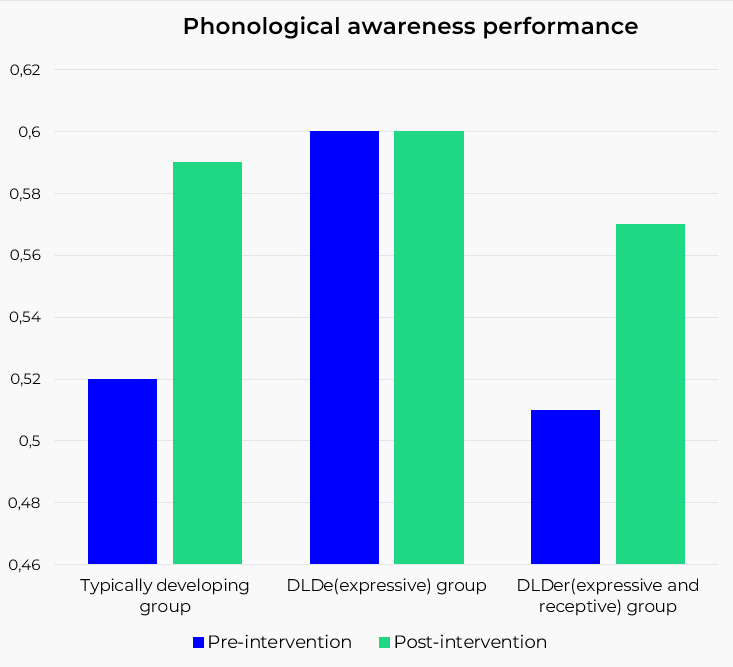
Well Played! Promoting Phonemic Awareness Training Using EdTech—GraphoGame Brazil—During the COVID-19 Pandemic
Article type
Report from Quasi-experimental study
Region
Brazil
Version of GraphoGame
GraphoGame Brazil
Participants
34
Grade
Grade1, Grade 2
Subject
Impact of GraphoGame literacy training during the height of COVID19 school closures, in Brazil.
Citations
3
The study examined the impact of an early literacy educational technology (EdTech) tool, GraphoGame Brazil, on developing foundational reading skills during the COVID-19 school closures in Brazil. A quasi-experimental pretest-posttest design was implemented with elementary students attending online classes. Participants were pseudo-randomly assigned to either an experimental group, which played GraphoGame Brazil, or an active control group, which engaged with an EdTech tool focusing on early numeracy skills. The intervention lasted six weeks, during which children in the experimental group played GraphoGame Brazil for five 15- to 20-minute sessions per week. The study aimed to evaluate whether GraphoGame Brazil could support the acquisition of early literacy skills despite the challenges posed by the pandemic.
Key findings
- GraphoGame intervention significantly improved word reading accuracy and uppercase rapid naming accuracy.
- GraphoGame group showcased a moderate improvement in: uppercase letter-naming accuracy, phoneme awareness
- Word reading efficiency did not show a significant difference, meaning speed of reading was not impacted.
- Word reading accuracy improved significantly in the GG group, with a notable increase in scores from pre- to post-test. This showcases the importance of GG in development of early literacy skills.
Marques de Souza, J. G., Weissheimer, J., & Buchweitz, A. (2022). Well played! Promoting phonemic awareness training using EdTech-GraphoGame Brazil during the COVID-19 pandemic. Brain Sciences, 12(11), 1494.
